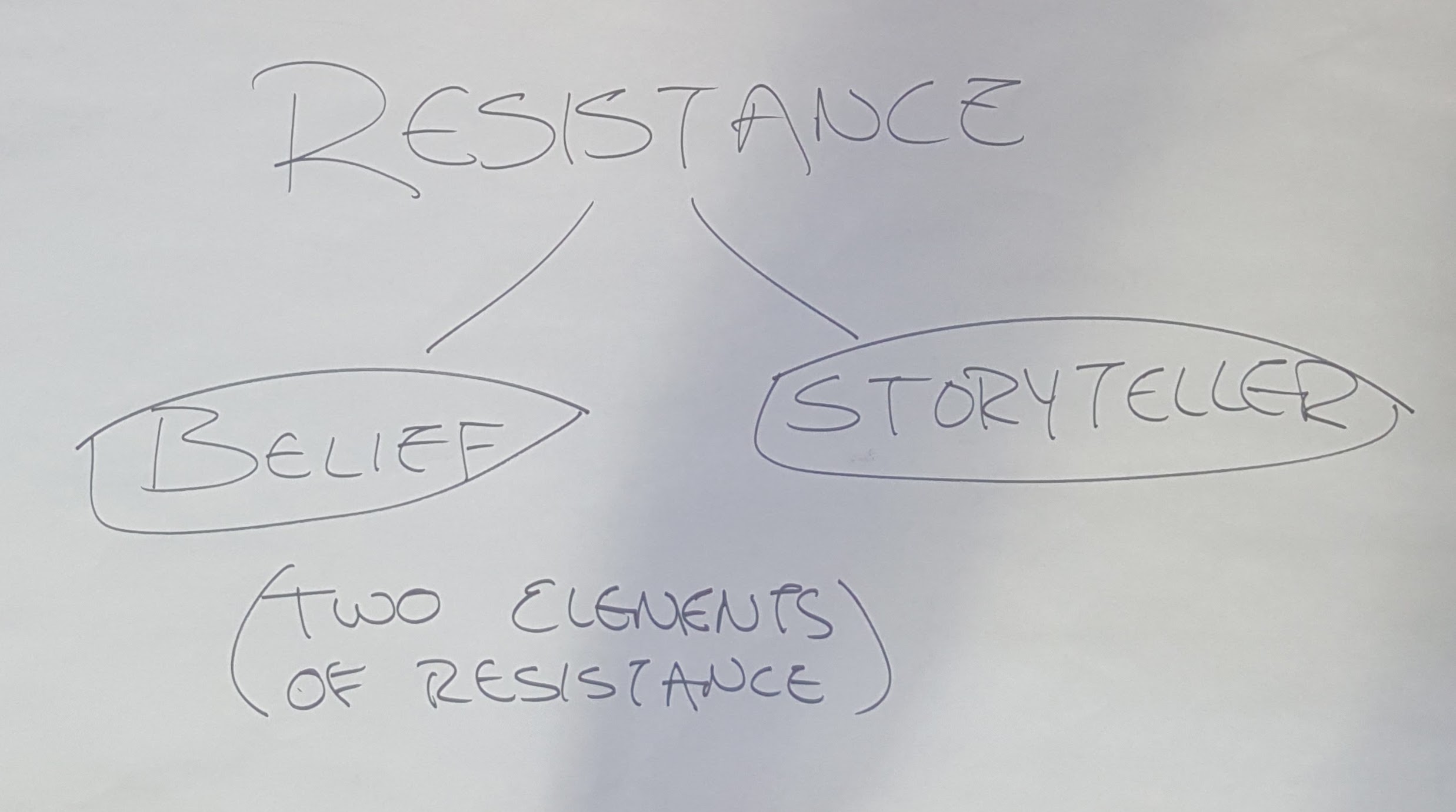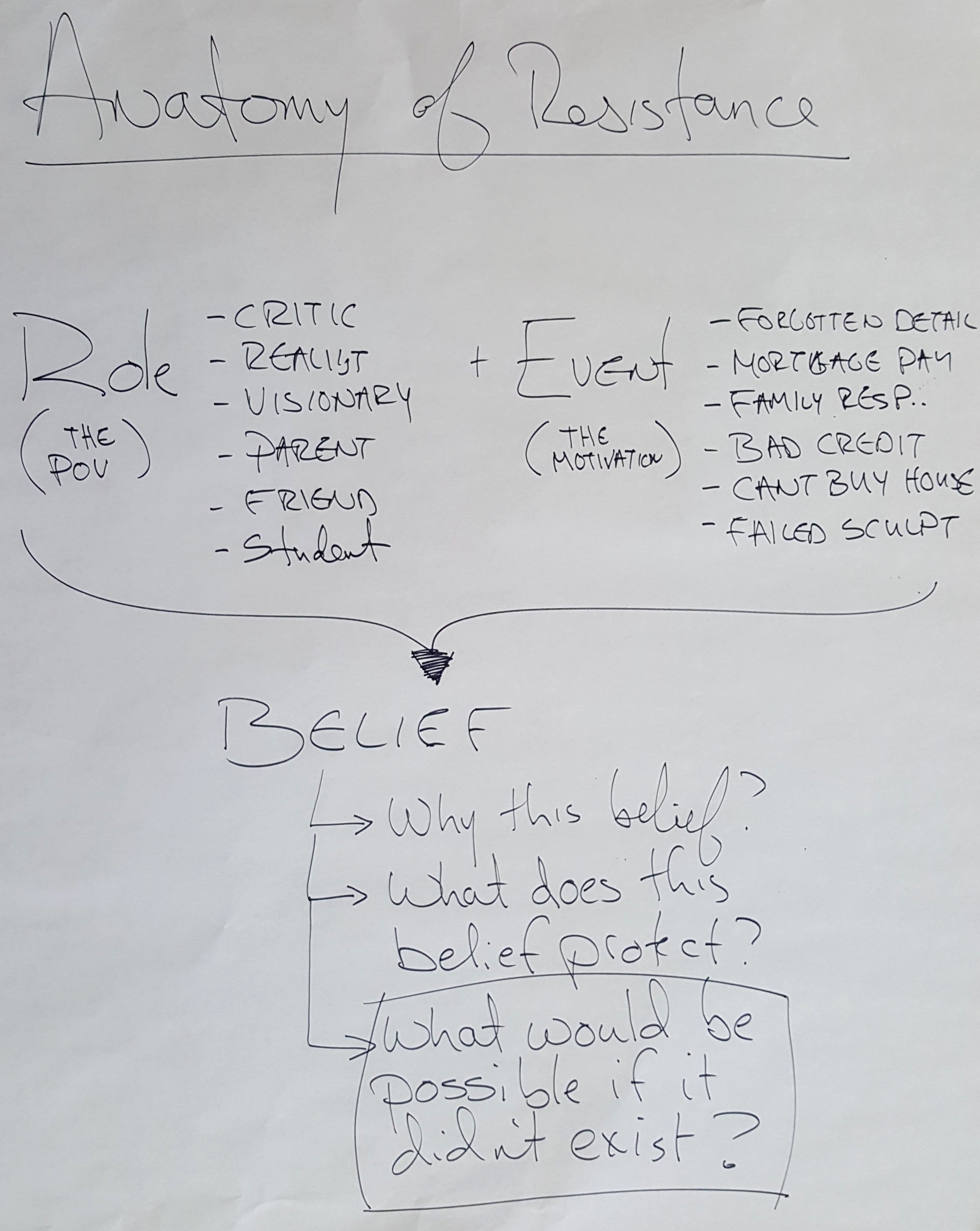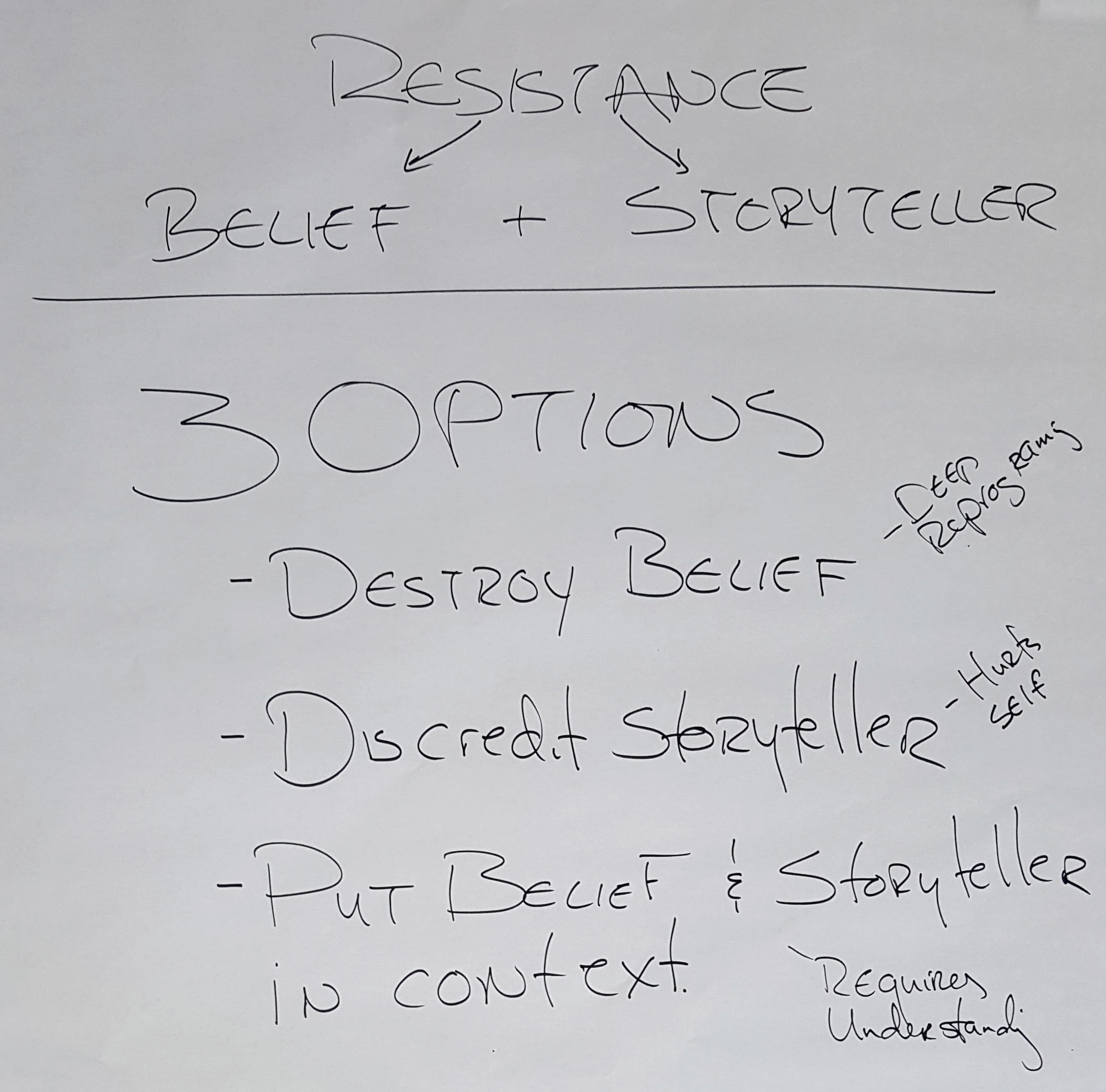Anatomy of Resistance

One of the universal laws of humanity is that any act of creativity or creation will be met with an equal and opposite reaction. We call this resistance.
Steven Pressfield has talked at length about resistance and has done amazing good for artists everywhere. In his words, Resistance is “experienced as fear; the degree of fear equates to the strength of Resistance. Therefore the more fear we feel about a specific enterprise, the more certain we can be that that enterprise is important to us and to the growth of our soul. That's why we feel so much Resistance. If it meant nothing to us, there'd be no Resistance.”
The experience of resistance comes in many forms. It comes as a feeling of pain or doubt or insecurity or even confusion in our creative process -- a crippling confusion that leaves us unable to decide or finalize a decision.

The most common place in which we experience resistance comes when we start to finish a work.
When all the detail starts to come sharper into focus and the reality of what the work is going to be becomes clearer and clearer, that is the most common place where we as artists meet resistance.
If we don't tackle resistance head on and if we continue to find ourselves in a loop cycling through passion and then pain, then resistance becomes more powerful. Then we begin to experience resistance earlier and earlier in our creative process. Like an immune system that's been compromised. And now, smaller and smaller actions will trigger it.
In its final phase, resistance stops us before we even start. In this stage, resistance has won. It has achieved its goal. All creative output is stopped. Resistance is not even felt anymore. Instead, we are left with a feeling of emptiness and unworthiness.
This is the moment when doubt in your ability is no longer doubt but actual knowledge that you can't.
This is the moment when you decide that you’re not an artist and that you never really had what it took.
Maybe you've already made these decisions in your life. Maybe somewhere along the way you already experienced this.
Still, some part of you wants you to read this. Some part of you is still looking for the way through.
It's to that part in you that the rest of this is dedicated. You are not alone. Even though you create by yourself, the experience of creating has, over the centuries, created a community of artists, writers, and musicians who have all experienced the same basic structures of the creative process.
We don't need to be fixed. We’re not broken. We are simply experiencing a journey that millions have experienced before us and billions will experience after us.
My job is to simply illuminate the milestones in the structures of the creative journey so that I leave a better road map to the creative process than I had when I started.

To understand resistance, you need to understand that it is composed of two parts: a belief and a storyteller.
In order for us to break through resistance, we need to do one of three things:
- Destroy the belief that is limiting us.
- Discredit the storyteller who keeps the belief alive.
- Put the belief and the storyteller into context so that we can choose what we wish to believe.
Let's first look at what a belief is and does. A belief uses language like “I can't,” “I don't,” “I'm not,” “I need” or “I should.”
A storyteller is a part of our life that has become crystallized and frozen in time in order to support that belief.
For example, one belief I had was that, in order for me to be a real artist, I had to draw a perfect circle like the divine Raphael.
At first, I had no idea where this belief came from. It just came up in part of the discovery work that you will be doing with my guidance. Later, I realized it came from my first art teacher, Craig Honeycut.
I was six years old and my mother would drive me to his house which was situated in the middle of a lumberyard. It was a small little house surrounded by tall bamboo and I remember sneaking out and running among the tall stacks of 2x4s with my friend Damon.
I remember having my first experience of the fear of heights there as well. I was standing on top of a stack of 2x4s and must have been about eight feet tall and suddenly I was overwhelmed by this anxiety that dropped me to my feet. I crawled on my belly to the edge of the 2x4s that I had crawled up. They led to a jagged sort of ladder that I could descend.
I can still vividly feel inside of me that moment of anxiety. It's buried deep inside me but I still carry it with me. This is what beliefs are. They come about because of specific responses that we have and they're buried deep inside us, but they are our guides.
Craig must have at one point told me a story of the divine Raphael and how he could draw a perfect circle because he'd achieved that level of mastery. I must have at that point internalized that as my North Star. That became the goal I must achieve. I was much too young to second guess the possibility of drawing a perfect circle or even realize that I had made it my North Star.
Alas, there it was. I thought: If you can't control your hand and draw the line exactly the way you want it, Ryan, then you are not a real artist. Full stop.
This belief caused me endless amounts of aggravation over decades of struggling with my skill and my vision. It slowed everything down. However, the most dangerous part of beliefs is when we begin to make judgments about ourselves and our process.
Have you already started to think about what beliefs you might have that are slowing you down or causing you to make judgments about yourself that aren't helpful?
In order to put this further in context and give you even more tools to understand your creative process, we have to look at the next component: The storyteller.
The storyteller is the part of you that created the belief in the first place. Whoever that storyteller is, they are still there. That's how beliefs work. They're actually one of humanity's great strengths. The fact that we can take experiences and crystallize them into beliefs that we can pass on from one generation to another via shared, and not direct, experiences is how we as a species have been able to, at this point, double the amount of our knowledge every 13 months.
While this is obviously an advantage, the disadvantage is that, when we make mistakes in our beliefs, those are also crystallized and passed on from generation to generation.
The key to decoding the belief and discovering the beliefs that do limit us is to discover who the storytellers are in our life.
It’s popular today to say that you are the average of your five closest friends. This, in my mind, is just another way of saying that your capacity is directly linked to the stories you are telling and that, if you want to achieve more in life, you need to surround yourself with better stories and better storytellers.
As a creator, you are often alone on your journey. You are often breaking through stories that others have already been telling you. So we must go deeper and look for who the storytellers are ourselves.
As mentioned before, a storyteller is simply a part of our own life that has become frozen in time in order to support a belief.
To understand storytellers, we need to look at the two elements that make them up: a role and an event.

Adults today often have 10+ different roles that they have to play on, if not a daily basis, then definitely a weekly basis. For example, we have to be friends, managers, parents, children, students, husbands or wives, accountants or lawyers or doctors or whatever our career is, and so much more.
A role, in simple terms, is simply a spectrum of behaviors that you and I are expected to follow in a specific context.
For example, we will use different language hanging out with our friends than we would if we were hanging out with our children. Our behavior is different because our role is different.
When we are with our best friend we say and do things that we would never do inside our work environment. It wouldn't be professional. These differences all come down to the role that we are playing at any given point.
You can think of roles as a series of rules that govern our behavior in a specific context. The simplest example is that, for many of us, swearing is perfectly acceptable when you're with friends but, when you're in an office environment, it's unprofessional.
The context that defines the area of a role comes down to a specific goal or motivation that we have. For example, in our professional life, our goal is usually to provide for ourselves or our family and so our motivations are focused around the amount of money that we bring in now and the amount of money that we will be able to bring in in the future via promotions and the career track.
To discover more about these rules, simply complete the following sentences:
In order for me to be a good parent, I must ...
In order for me to be a good student, I must ...
In order for me to be a good boss, I must ...
Using that simple structure, you can discover the rules for anything. Just insert the role that you want in place of “boss” or “parent” or “student.”
To tap into what your rules are for what an artist is, then simply ask yourself the following question:
In order for me to be an artist, I must ...
Complete that 10 times and write down whatever comes to mind. Do not censor. Do not stop. If nothing comes to mind then write “nothing comes to mind.”
Then, ask yourself this next question:
In order for something to be art, it must ...
Same deal. Ask yourself this 10 times and write down the response no matter what.
This is how I discovered my own rule that, in order for me to be an artist, I must be able to draw a perfect circle.
Once you have discovered the rules that exist for this role, we can begin to look at the second component of the storyteller: the event.
As I mentioned before, resistance comes from two things. A belief and a storyteller. The storyteller is a crystallized part of our self that continues to believe something about us or our process. This belief may be what is slowing us down.
Then, when we look at the storyteller, we see that there are two parts to him: a role and an event. It is that second part, the event, that crystallizes a specific belief in our mind.
Events are really just life events that can happen to anybody. Things like being late, missing a bill and having it negatively affect your credit, being turned down for a loan, being unable to afford that dream home, getting a bad grade and disappointing your mother. It could also be disappointing ourselves. It could come from creating something and being profoundly disappointed in your own ability. It could be getting married or having a child.
The storyteller is formed when a particular role that we have encounters one of these events and then formulates a belief that is then crystallized inside us.
Let's take a simple example. When I first arrived in LA, I had no idea how long it took to get to a destination. I would leave 15 minutes before and find myself 30 minutes late. No matter where I went in LA, this was the case.
This went on for about six months, until I was an hour late to my friend's birthday party and they were already wrapping up. Eventually, I associated enough pain with the experience of being late that I formulated the belief that on time means you're already late. This meant that, in order for you to be on time you must be early.
The storyteller here was the good Ryan, the good friend, the good guy, the responsible Ryan.
When I married my wife, who is from India, this was sorely put to the test. I remember showing up to events late and viscerally feeling this great disappointment in myself. It took me a long time to realize where this belief was coming from. When I did, though, I was able to have a conversation with myself about whether or not I wanted to keep that belief or if it was, in fact, limiting me today.
Another example is when the inner critic, another very important role that we have inside of ourselves and one that we will talk about at length later, is looking at the work of other people and starts making judgments about our own work. In that event, I might make all sorts of beliefs about what I should or should not be doing and even beliefs of what I can and cannot do. I might decide that I'm not actually a sculptor because I'm not as good as this other artist.
If I'm not awake to this subconscious process, then that singular belief might snowball into a whole host of behaviors and beliefs that all lead to one destination: failure.
That's how resistance works. It gathers beliefs and storytellers to it until they can snowball into a large enough effect to stop you.

As mentioned towards the beginning of this chapter, you have three ways to beat resistance.
- Destroy the belief that is limiting us.
- Discredit the storyteller who keeps the belief alive.
- Put the belief and the storyteller into context so that we can choose what we wish to believe.
In order to destroy a belief we must undergo deep reprogramming using mantras, visualization and other tactics.
If we discredit the storyteller, we risk discrediting a part of ourselves. For example, our inner critic is usually one of the most difficult parts of the creative process. We are usually harder on ourselves then we would ever be on anybody else.
However, if you understand that the inner critic has one job and if you accept that that job is to simply protect you -- the artist -- from embarrassment or something negative then you might learn to see this critic as a valuable part of the process. Not a part of the creation process but, certainly, on the review committee.
The third option is the one that I believe in. Put the belief and the storyteller into context to understand where they came from so that you can then have a conversation and choose whether or not this is a valuable belief or not.
For example, the belief that in order for me to be an artist I must be able to draw a perfect circle might actually be valuable for a period of my life because it will provide fuel for me to improve my technique and my physical abilities. However, as time progresses and I move into a phase where I am focused on my own vision, then this will certainly be a distraction as it has been.
“Darkness cannot drive out darkness: only light can do that,” said Martin Luther King, Jr.
As artists, our job is to go into a dark wood and discover something new but in the shape of ourselves. For many of us, we may think that we are searching for the light. But, as I have gone down this journey, I have learned that we bring the light with us.
As seekers, we are always looking for a place to belong and we find our home when we realize that we already do.
You don't need to be fixed. You are not broken. You're just experiencing the creative journey that's been experienced by millions before you and will be experienced by billions after you. As you struggle on this journey, try to keep that in perspective and never forget that you are the light that will illuminate your dark.
Stay connected with news and updates!
Join our mailing list to receive the latest news and updates from our team.
Don't worry, your information will not be shared.
